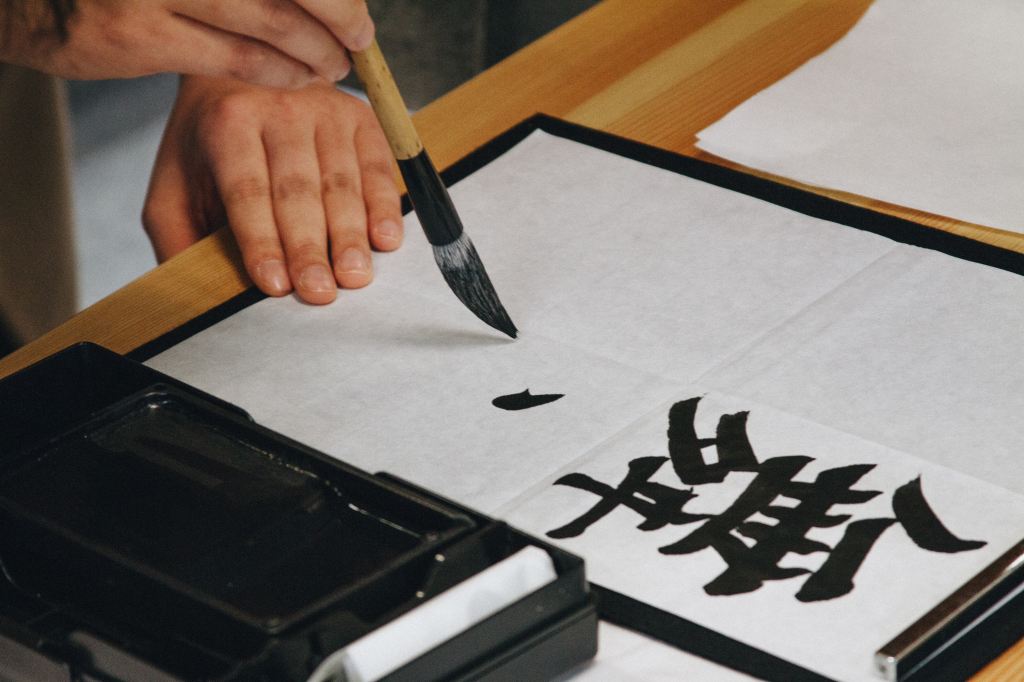Swish. Swash. My Japanese brush pen streaks down the white paper, making a pitch-black line on the surface. I raise my brush pen but only slightly, and now I create a swift line across the paper. I have just written the kanji 十, meaning ten.
This is Japanese calligraphy, which I learn with my brother every week. Each month, we keep practicing a few selected words and give the final product to another teacher who inspects it and chooses to make our rank in calligraphy higher or not to change it.
Japanese calligraphy is called shuji (pronounced shuuji) and is practiced by many Japanese people. Its a very good way to develop neater hand-writing and is simply beautiful on its own.

We have a fabulous teacher that teaches us shuji. She uses wild hand motions and funny examples to lead us through the path of shuji mastery. I get better and better each time I practice, and I enjoy practicing it. My teacher helped me to enjoy it even more.
Shuji has been and will be used often, in different events and happenings. For example, when a father or a mother choose their baby’s name, they write the name on a piece of paper with a brush. Even when the new era name was chosen in April this year, it was written with a brush and fit into a frame. Fun fact: Shuji was actually one of the highest skills a nobleman could have from about 2000 years ago when it was made, till the end of the Edo Period (1868)!
So after some history, background, and facts about shuji, I am giving you an offer. If you comment below, you have the chance to make me write a word you like to Japanese! With a traditional brush! The winner (or winners if there are many participants) will be announced on November 16th.
*EDIT: If you want a specific word/words, then you can comment in either language, and I will write that in Japanese!
Well, that’s it for this post! Bye, and God bless!

EEP! This sounds awesome! I never knew all this about shuji! I have known it to be a very beautiful “art”, and I started learning how to write it, but I somewhat got distracted with authorship instead. =D Like always, awesome post!
LikeLiked by 1 person
Thank you for reading it, Kirsten! I really appreciate it!
LikeLike
Also, if I do happen to be the lucky winner, I would love to see the word “Author” written in shuji!
LikeLiked by 1 person
Ooh! That is a great word Kirsten! I will keep that as an entry!
LikeLike
This is so cool! I’ve always found far eastern calligraphy fascinating. It’s so beautiful! Could you write the word ‘joy’?
LikeLiked by 1 person
Yes, it is indeed very beautiful! Thank you for taking your time to read the post!
Yes! Thank you for your entry.
LikeLike
I used to learn a little bit of Kanji when I learnt Japanese at school! Shuji is incredible! Great blog post Noah 🙂 I’m not sure what word I would choose, maybe “Joy” or “Dream” 🙂
LikeLiked by 1 person
Cool! Shuji is indeed incredible. Thank you so much for reading, Trudy!
Somebody already voted for “Joy”, so I will keep your entry as “dream”. Is that okay?
LikeLike
Great post! Nice to know a bit of history regarding Japanese Calligraphy.
My ? , is there a Chinese calligraphy? If yes, how is it different?
My word I’d would choose is[ Thankful].
Thankful for your work in Japan.
Blessings from Bella Vista Ark, USA.
Alice.
LikeLiked by 1 person
Thank you so much for taking time to look at it, Alice!
The answer to that would be like this: There is Chinese calligraphy. Japanese calligraphy originated from Chinese calligraphy, but Japanese calligraphy has things called hiragana (words like あ) and katana (words like ア) even sometimes mixed into it.
I talk more about this in this post: https://lifeinkyoto.home.blog/2019/07/27/hiragana-katakana-and-kanji/
Thankful is a great word! I will keep that as a vote! Thank you!
LikeLike
Hey Noah! It’s great that you get to take some classed nearby while you’re homeschooled. I tried to write in Kanji once, but it was a lot harder than it looks.
I like the word ‘perseverance’ personally.
LikeLiked by 1 person
It is definitely great! Kanji is so hard, but fun to learn … it’s worth.
Okay Celeste! I’ll keep that it mind!
LikeLike
Noah, This blog was precious. I would like the word, LOVE. Thanks, Grandma W.
LikeLiked by 1 person
Thank you so much, Grandma! I will add that as an option.
LikeLike
This is great, Noah! I throughly enjoyed my little exposure I had to the art of shuji (and see my daughter attempt it in a class activity as well!)
If I’m the winner, I’d like melancholy (憂鬱)or lemon (檸檬) , please! 笑う
LikeLike
Thank you, Ruth Ann! Those are some hard words! LOL I hope I can write them if you win.
LikeLike
[…] you know, I announced previously that the winners of the shuji giveaway would be known to all on the 16th. And that’s in two […]
LikeLike